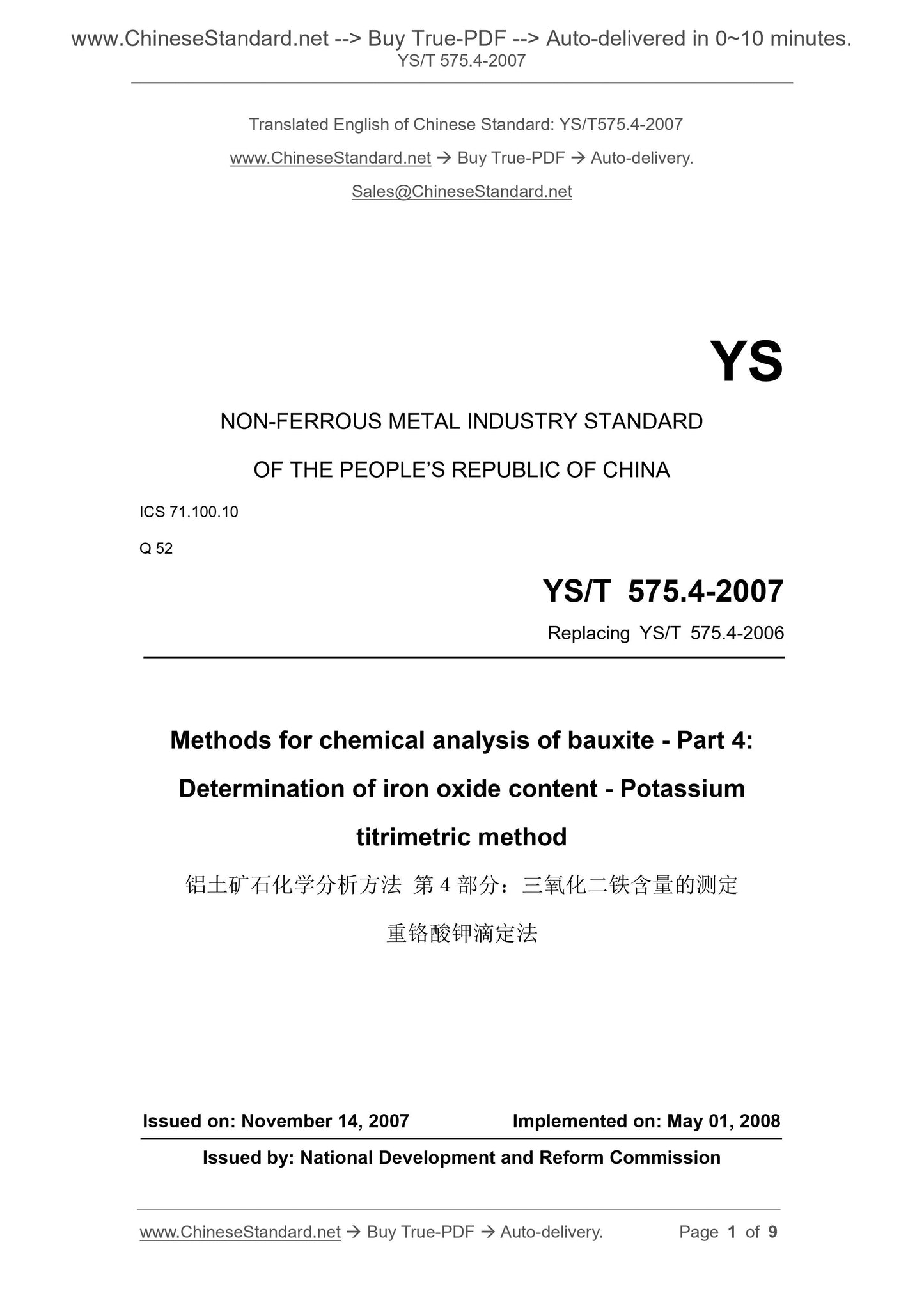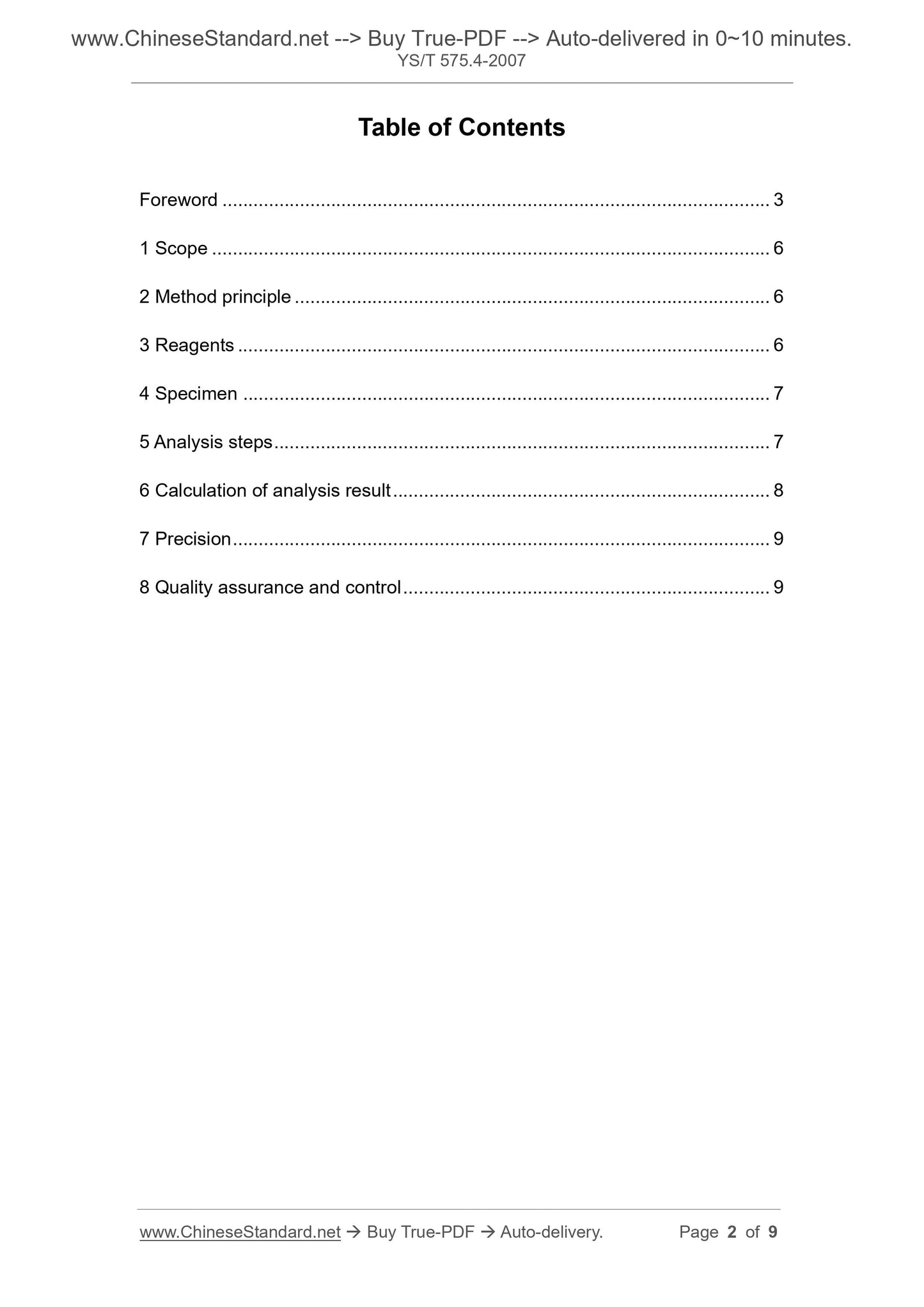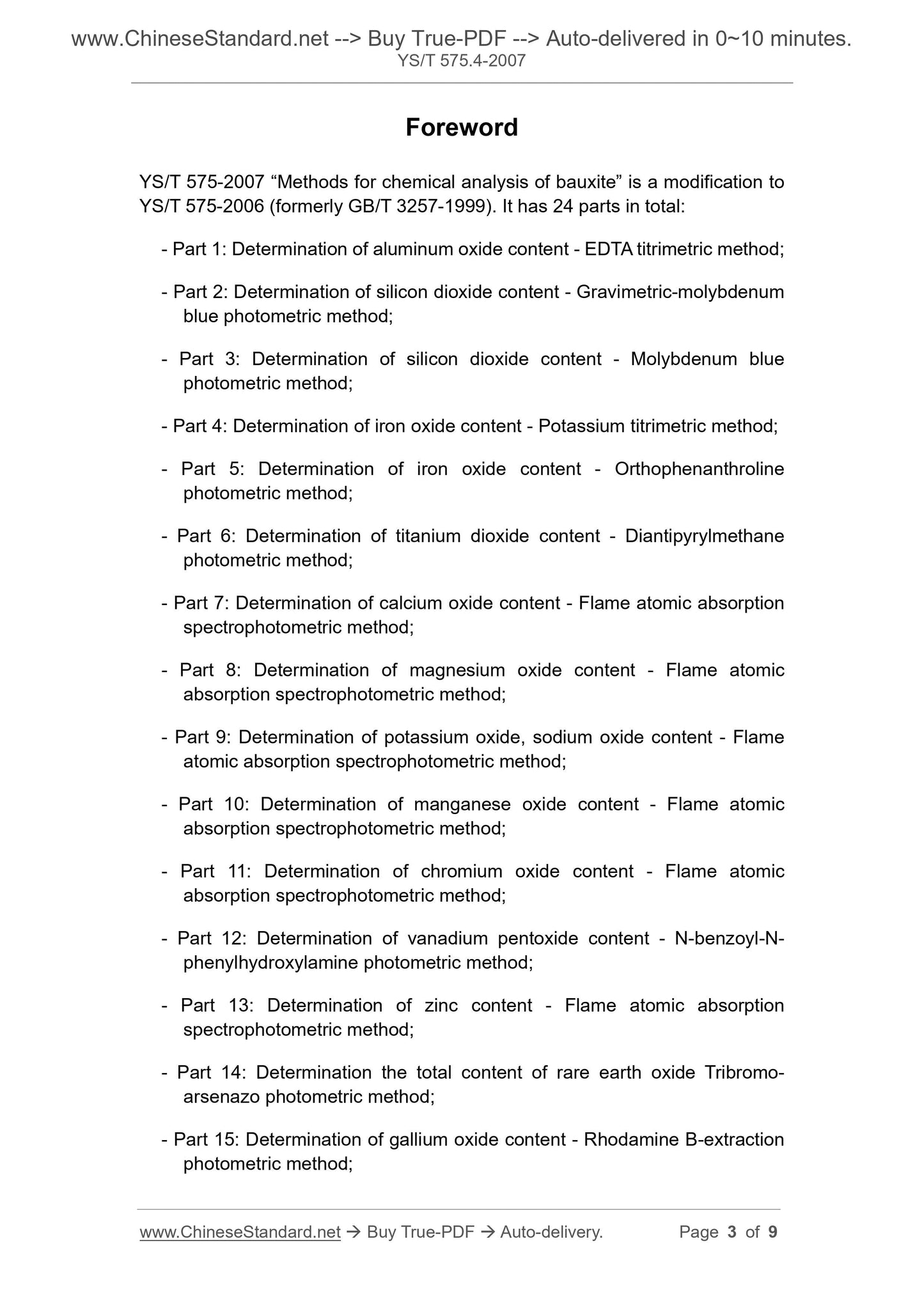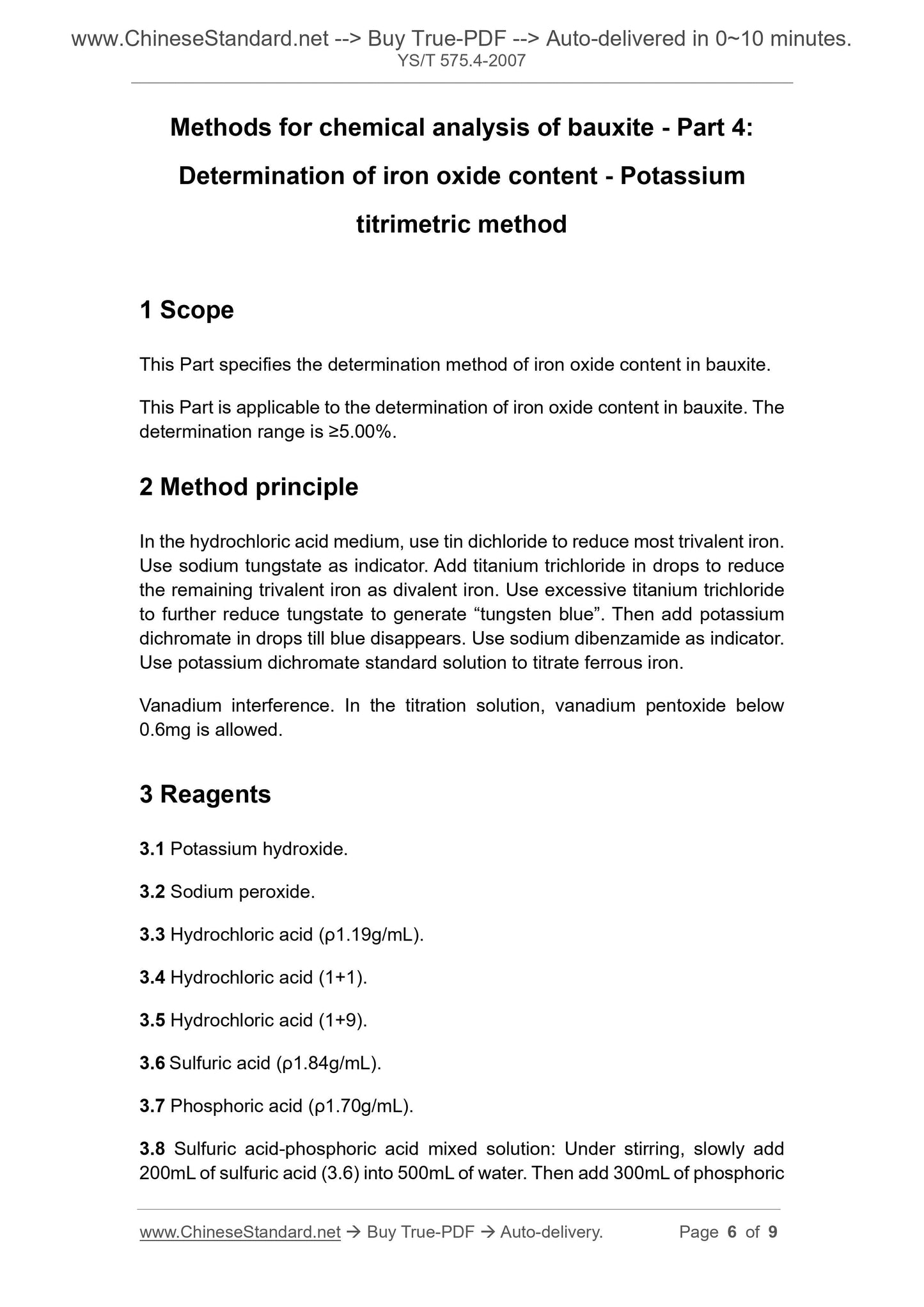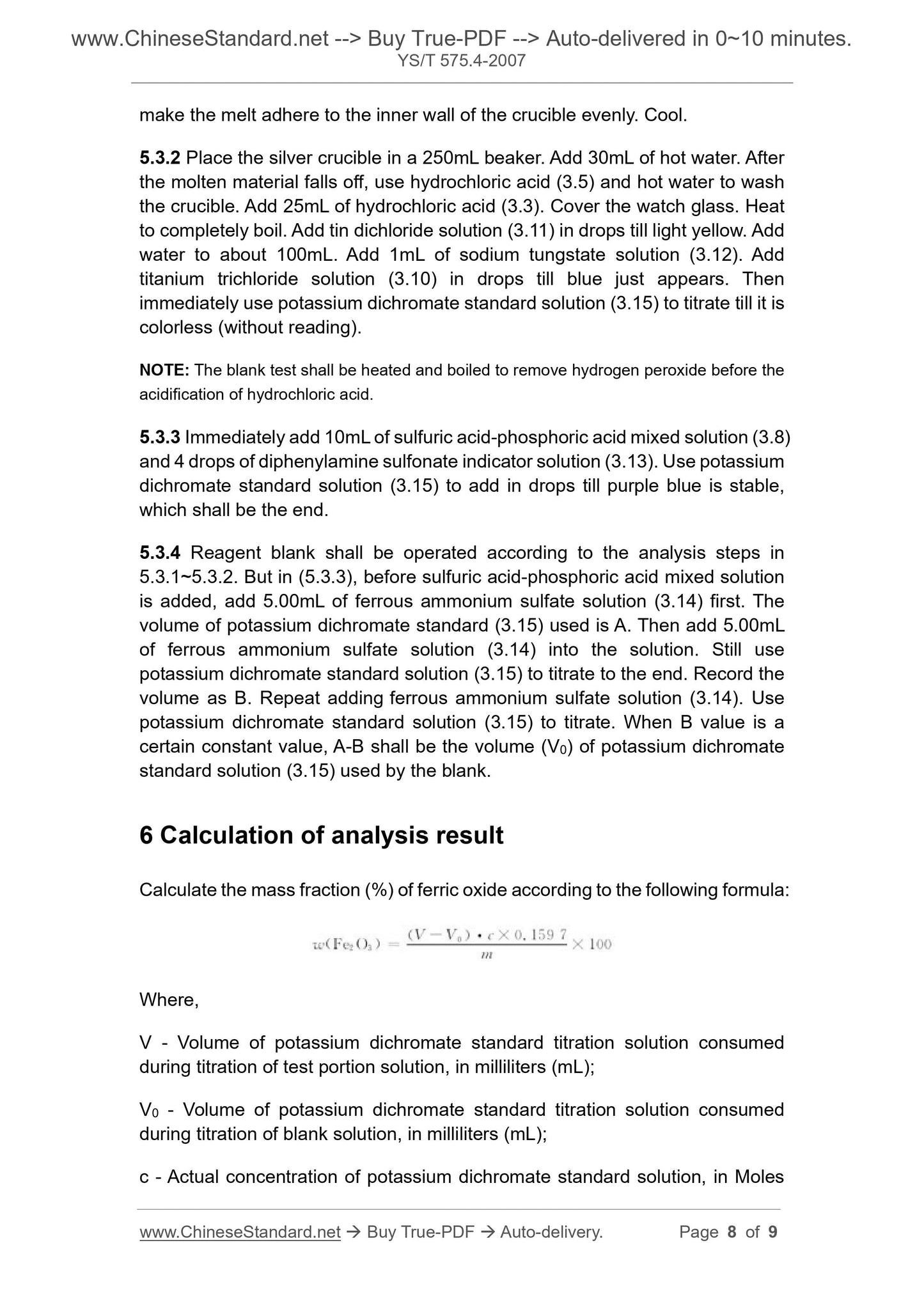1
/
από
5
PayPal, credit cards. Download editable-PDF & invoice in 1 second!
YS/T 575.4-2007 English PDF (YST575.4-2007)
YS/T 575.4-2007 English PDF (YST575.4-2007)
Κανονική τιμή
$90.00 USD
Κανονική τιμή
Τιμή έκπτωσης
$90.00 USD
Τιμή μονάδας
/
ανά
Τα έξοδα αποστολής υπολογίζονται κατά την ολοκλήρωση της αγοράς.
Δεν ήταν δυνατή η φόρτωση της διαθεσιμότητας παραλαβής
Delivery: 3 seconds. Download true-PDF + Invoice.
Get QUOTATION in 1-minute: Click YS/T 575.4-2007
Historical versions: YS/T 575.4-2007
Preview True-PDF (Reload/Scroll if blank)
YS/T 575.4-2007: Methods for chemical analysis of bauxite. Part 4: Determination of iron oxide content. Dichromate titrimetric method
YS/T 575.4-2007
NON-FERROUS METAL INDUSTRY STANDARD
OF THE PEOPLE’S REPUBLIC OF CHINA
ICS 71.100.10
Q 52
Replacing YS/T 575.4-2006
Methods for chemical analysis of bauxite - Part 4:
Determination of iron oxide content - Potassium
titrimetric method
ISSUED ON: NOVEMBER 14, 2007
IMPLEMENTED ON: MAY 01, 2008
Issued by: National Development and Reform Commission
Table of Contents
Foreword ... 3
1 Scope ... 6
2 Method principle ... 6
3 Reagents ... 6
4 Specimen ... 7
5 Analysis steps ... 7
6 Calculation of analysis result ... 8
7 Precision ... 9
8 Quality assurance and control ... 9
Foreword
YS/T 575-2007 “Methods for chemical analysis of bauxite” is a modification to
YS/T 575-2006 (formerly GB/T 3257-1999). It has 24 parts in total:
- Part 1: Determination of aluminum oxide content - EDTA titrimetric method;
- Part 2: Determination of silicon dioxide content - Gravimetric-molybdenum
blue photometric method;
- Part 3: Determination of silicon dioxide content - Molybdenum blue
photometric method;
- Part 4: Determination of iron oxide content - Potassium titrimetric method;
- Part 5: Determination of iron oxide content - Orthophenanthroline
photometric method;
- Part 6: Determination of titanium dioxide content - Diantipyrylmethane
photometric method;
- Part 7: Determination of calcium oxide content - Flame atomic absorption
spectrophotometric method;
- Part 8: Determination of magnesium oxide content - Flame atomic
absorption spectrophotometric method;
- Part 9: Determination of potassium oxide, sodium oxide content - Flame
atomic absorption spectrophotometric method;
- Part 10: Determination of manganese oxide content - Flame atomic
absorption spectrophotometric method;
- Part 11: Determination of chromium oxide content - Flame atomic
absorption spectrophotometric method;
- Part 12: Determination of vanadium pentoxide content - N-benzoyl-N-
phenylhydroxylamine photometric method;
- Part 13: Determination of zinc content - Flame atomic absorption
spectrophotometric method;
- Part 14: Determination the total content of rare earth oxide Tribromo-
arsenazo photometric method;
- Part 15: Determination of gallium oxide content - Rhodamine B-extraction
photometric method;
Methods for chemical analysis of bauxite - Part 4:
Determination of iron oxide content - Potassium
titrimetric method
1 Scope
This Part specifies the determination method of iron oxide content in bauxite.
This Part is applicable to the determination of iron oxide content in bauxite. The
determination range is ≥5.00%.
2 Method principle
In the hydrochloric acid medium, use tin dichloride to reduce most trivalent iron.
Use sodium tungstate as indicator. Add titanium trichloride in drops to reduce
the remaining trivalent iron as divalent iron. Use excessive titanium trichloride
to further reduce tungstate to generate “tungsten blue”. Then add potassium
dichromate in drops till blue disappears. Use sodium dibenzamide as indicator.
Use potassium dichromate standard solution to titrate ferrous iron.
Vanadium interference. In the titration solution, vanadium pentoxide below
0.6mg is allowed.
3 Reagents
3.1 Potassium hydroxide.
3.2 Sodium peroxide.
3.3 Hydrochloric acid (ρ1.19g/mL).
3.4 Hydrochloric acid (1+1).
3.5 Hydrochloric acid (1+9).
3.6 Sulfuric acid (ρ1.84g/mL).
3.7 Phosphoric acid (ρ1.70g/mL).
3.8 Sulfuric acid-phosphoric acid mixed solution: Under stirring, slowly add
200mL of sulfuric acid (3.6) into 500mL of water. Then add 300mL of phosphoric
make the melt adhere to the inner wall of the crucible evenly. Cool.
5.3.2 Place the silver crucible in a 250mL beaker. Add 30mL of hot water. After
the molten material falls off, use hydrochloric acid (3.5) and hot water to wash
the crucible. Add 25mL of hydrochloric acid (3.3). Cover the watch glass. Heat
to completely boil. Add tin dichloride solution (3.11) in drops till light yellow. Add
water to about 100mL. Add 1mL of sodium tungstate solution (3.12). Add
titanium trichloride solution (3.10) in drops till blue just appears. Then
immediately use potassium dichromate standard solution (3.15) to titrate till it is
colorless (without reading).
NOTE: The blank test shall be heated and boiled to remove hydrogen peroxide before the
acidification of hydrochloric acid.
5.3.3 Immediately add 10mL of sulfuric acid-phosphoric acid mixed solution (3.8)
and 4 drops of diphenylamine sulfonate indicator solution (3.13). Use potassium
dichromate standard solution (3.15) to add in drops till purple blue is stable,
which shall be the end.
5.3.4 Reagent blank shall be operated according to the analysis steps in
5.3.1~5.3.2. But in (5.3.3), before sulfuric acid-phosphoric acid mixed solution
is added, add 5.00mL of ferrous ammonium sulfate solution (3.14) first. The
volume of potassium dichromate standard (3.15) used is A. Then add 5.00mL
of ferrous ammonium sulfate solution (3.14) into the solution. Still use
potassium dichromate standard solution (3.15) to titrate to the end. Record the
volume as B. Repeat adding ferrous ammonium sulfate solution (3.14). Use
potassium dichromate standard solution (3.15) to titrate. When B value is a
certain constant value, A-B shall be the volume (V0) of potassium dichromate
standard solution (3.15) used by the blank.
6 Calculation of analysis result
Calculate the mass fraction (%) of ferric oxide according to the following formula:
Where,
V - Volume of potassium dichromate standard titration solution consumed
during titration of test portion solution, in milliliters (mL);
V0 - Volume of potassium dichromate standard titration solution consumed
during titration of blank solution, in milliliters (mL);
c - Actual concentration of potassium dichromate standard solution, in Moles
Get QUOTATION in 1-minute: Click YS/T 575.4-2007
Historical versions: YS/T 575.4-2007
Preview True-PDF (Reload/Scroll if blank)
YS/T 575.4-2007: Methods for chemical analysis of bauxite. Part 4: Determination of iron oxide content. Dichromate titrimetric method
YS/T 575.4-2007
NON-FERROUS METAL INDUSTRY STANDARD
OF THE PEOPLE’S REPUBLIC OF CHINA
ICS 71.100.10
Q 52
Replacing YS/T 575.4-2006
Methods for chemical analysis of bauxite - Part 4:
Determination of iron oxide content - Potassium
titrimetric method
ISSUED ON: NOVEMBER 14, 2007
IMPLEMENTED ON: MAY 01, 2008
Issued by: National Development and Reform Commission
Table of Contents
Foreword ... 3
1 Scope ... 6
2 Method principle ... 6
3 Reagents ... 6
4 Specimen ... 7
5 Analysis steps ... 7
6 Calculation of analysis result ... 8
7 Precision ... 9
8 Quality assurance and control ... 9
Foreword
YS/T 575-2007 “Methods for chemical analysis of bauxite” is a modification to
YS/T 575-2006 (formerly GB/T 3257-1999). It has 24 parts in total:
- Part 1: Determination of aluminum oxide content - EDTA titrimetric method;
- Part 2: Determination of silicon dioxide content - Gravimetric-molybdenum
blue photometric method;
- Part 3: Determination of silicon dioxide content - Molybdenum blue
photometric method;
- Part 4: Determination of iron oxide content - Potassium titrimetric method;
- Part 5: Determination of iron oxide content - Orthophenanthroline
photometric method;
- Part 6: Determination of titanium dioxide content - Diantipyrylmethane
photometric method;
- Part 7: Determination of calcium oxide content - Flame atomic absorption
spectrophotometric method;
- Part 8: Determination of magnesium oxide content - Flame atomic
absorption spectrophotometric method;
- Part 9: Determination of potassium oxide, sodium oxide content - Flame
atomic absorption spectrophotometric method;
- Part 10: Determination of manganese oxide content - Flame atomic
absorption spectrophotometric method;
- Part 11: Determination of chromium oxide content - Flame atomic
absorption spectrophotometric method;
- Part 12: Determination of vanadium pentoxide content - N-benzoyl-N-
phenylhydroxylamine photometric method;
- Part 13: Determination of zinc content - Flame atomic absorption
spectrophotometric method;
- Part 14: Determination the total content of rare earth oxide Tribromo-
arsenazo photometric method;
- Part 15: Determination of gallium oxide content - Rhodamine B-extraction
photometric method;
Methods for chemical analysis of bauxite - Part 4:
Determination of iron oxide content - Potassium
titrimetric method
1 Scope
This Part specifies the determination method of iron oxide content in bauxite.
This Part is applicable to the determination of iron oxide content in bauxite. The
determination range is ≥5.00%.
2 Method principle
In the hydrochloric acid medium, use tin dichloride to reduce most trivalent iron.
Use sodium tungstate as indicator. Add titanium trichloride in drops to reduce
the remaining trivalent iron as divalent iron. Use excessive titanium trichloride
to further reduce tungstate to generate “tungsten blue”. Then add potassium
dichromate in drops till blue disappears. Use sodium dibenzamide as indicator.
Use potassium dichromate standard solution to titrate ferrous iron.
Vanadium interference. In the titration solution, vanadium pentoxide below
0.6mg is allowed.
3 Reagents
3.1 Potassium hydroxide.
3.2 Sodium peroxide.
3.3 Hydrochloric acid (ρ1.19g/mL).
3.4 Hydrochloric acid (1+1).
3.5 Hydrochloric acid (1+9).
3.6 Sulfuric acid (ρ1.84g/mL).
3.7 Phosphoric acid (ρ1.70g/mL).
3.8 Sulfuric acid-phosphoric acid mixed solution: Under stirring, slowly add
200mL of sulfuric acid (3.6) into 500mL of water. Then add 300mL of phosphoric
make the melt adhere to the inner wall of the crucible evenly. Cool.
5.3.2 Place the silver crucible in a 250mL beaker. Add 30mL of hot water. After
the molten material falls off, use hydrochloric acid (3.5) and hot water to wash
the crucible. Add 25mL of hydrochloric acid (3.3). Cover the watch glass. Heat
to completely boil. Add tin dichloride solution (3.11) in drops till light yellow. Add
water to about 100mL. Add 1mL of sodium tungstate solution (3.12). Add
titanium trichloride solution (3.10) in drops till blue just appears. Then
immediately use potassium dichromate standard solution (3.15) to titrate till it is
colorless (without reading).
NOTE: The blank test shall be heated and boiled to remove hydrogen peroxide before the
acidification of hydrochloric acid.
5.3.3 Immediately add 10mL of sulfuric acid-phosphoric acid mixed solution (3.8)
and 4 drops of diphenylamine sulfonate indicator solution (3.13). Use potassium
dichromate standard solution (3.15) to add in drops till purple blue is stable,
which shall be the end.
5.3.4 Reagent blank shall be operated according to the analysis steps in
5.3.1~5.3.2. But in (5.3.3), before sulfuric acid-phosphoric acid mixed solution
is added, add 5.00mL of ferrous ammonium sulfate solution (3.14) first. The
volume of potassium dichromate standard (3.15) used is A. Then add 5.00mL
of ferrous ammonium sulfate solution (3.14) into the solution. Still use
potassium dichromate standard solution (3.15) to titrate to the end. Record the
volume as B. Repeat adding ferrous ammonium sulfate solution (3.14). Use
potassium dichromate standard solution (3.15) to titrate. When B value is a
certain constant value, A-B shall be the volume (V0) of potassium dichromate
standard solution (3.15) used by the blank.
6 Calculation of analysis result
Calculate the mass fraction (%) of ferric oxide according to the following formula:
Where,
V - Volume of potassium dichromate standard titration solution consumed
during titration of test portion solution, in milliliters (mL);
V0 - Volume of potassium dichromate standard titration solution consumed
during titration of blank solution, in milliliters (mL);
c - Actual concentration of potassium dichromate standard solution, in Moles
Share
